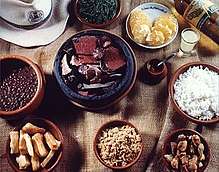Catupiry
Catupiry (Portuguese pronunciation: [katupiˈɾi]) is one of the most popular brands of requeijão in Brazil. It was developed by Italian immigrant Mario Silvestrini in the state of Minas Gerais in 1911.[1] The name derives from the Tupi word meaning "excellent".[2]
 |
| Part of a series on |
| Brazilian cuisine |
|---|
| Types of food |
| See also |
|

Catupiry is a soft, mild-tasting cheese that can be spread over toasts, crackers and bread buns or used in cooking. Because of its low level of acidity, catupiry has become an ingredient in various dishes.
The expression com catupiry (with catupiry) refers to foods where catupiry or an imitation of it is an ingredient, or a filling, such as pizzas, coxinhas or pães-de-queijo. As a kind of requeijão, much as any other soft-tasting white cheese, it is also eaten as a dessert combined with guava paste, what is called romeu-e-julieta.
See also
References
- "A Empresa Catupiry Laticínios". Catupiry. Archived from the original on 2012-10-30. Retrieved 11 November 2012.
- Ayala, Valentín (2000). Gramática Guaraní. Asunción: Centro Editorial Paraguayo S.R.L. p. 49